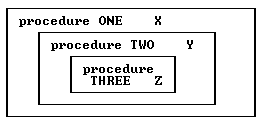Scope is the feature that makes names active only in certain parts of a program. A name declared in one part does not necessarily conflict with the same name declared in another part. Scope is what makes a program modular.
When a name is active, it is in scope. At any point in the program certain names are in scope and available, while others are out of scope and nonexistent. A name is in scope from the point it is declared to the end of the procedure in which its declaration appears. It is active in any sub-procedures that might be nested in the procedure. Usually we think of scope applying to variable names, but it applies to procedure names, as well as all other names.
Here are some nested procedures with a variable declared in each one:
procedure ONE;
integer X;
procedure TWO;
integer Y;
procedure THREE;
integer Z;
begin
. . .
end;
begin \TWO
. . .
end;
begin \ONE
. . .
end;
Here is another way of looking at these same nested procedures:

The statements inside procedure ONE can call procedure TWO because both the call and procedure TWO are within procedure ONE. However, the statements inside procedure ONE cannot call procedure THREE because the scope of THREE ends at the end of procedure TWO.
For similar reasons, only the variable X is in scope for the statements inside procedure ONE. Procedure TWO can access variables X and Y, and it can call procedures ONE, TWO, and THREE. Procedure THREE can access all the variables, X, Y, and Z, and can call procedures, ONE, TWO, and THREE.
Note that a procedure is in scope during its own body code, so a procedure can call itself. (See: Recursion.)
Two procedures at the same level, but nested inside different procedures, cannot call each other. For example:

Procedures B and TWO cannot call each other because they are not in scope with each other. The scope of B ends at the end of procedure A. However, statements in procedures ONE and TWO can call procedure A, and conversely, statements in A and B can call procedure ONE. (See: Forward Procedures.)
In XPL0, names in scope with each other and at the same level must be unique in their first 16 characters, otherwise a compile error occurs (ERROR 11: NAME ALREADY DECLARED). However, there is no conflict if the identical names are declared in different scopes or in the same scope but in procedures nested at different levels. For example, "integer Frog" can be declared in all four of the procedures: A, B, ONE, and TWO, without conflict. Each declaration creates a separate variable, so there are four unique variables that have the same name.
When the same name is declared at different levels in nested procedures, the most local declaration is used. In the last example suppose the nested procedures A and B both have "integer Frog" declared in them. When a statement in procedure B refers to Frog, it refers to the local Frog declared in B, not the global one in A. Statements in procedure A use the Frog declared in A.